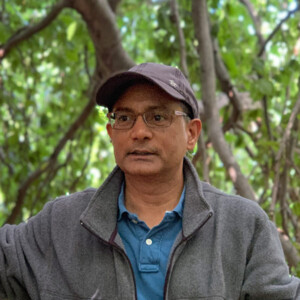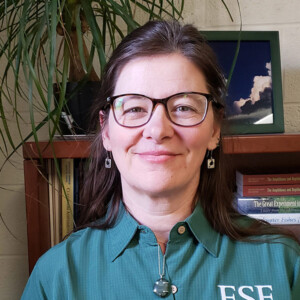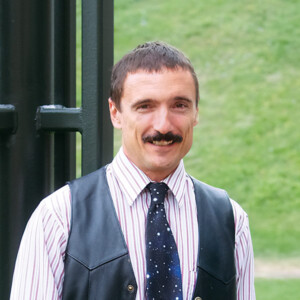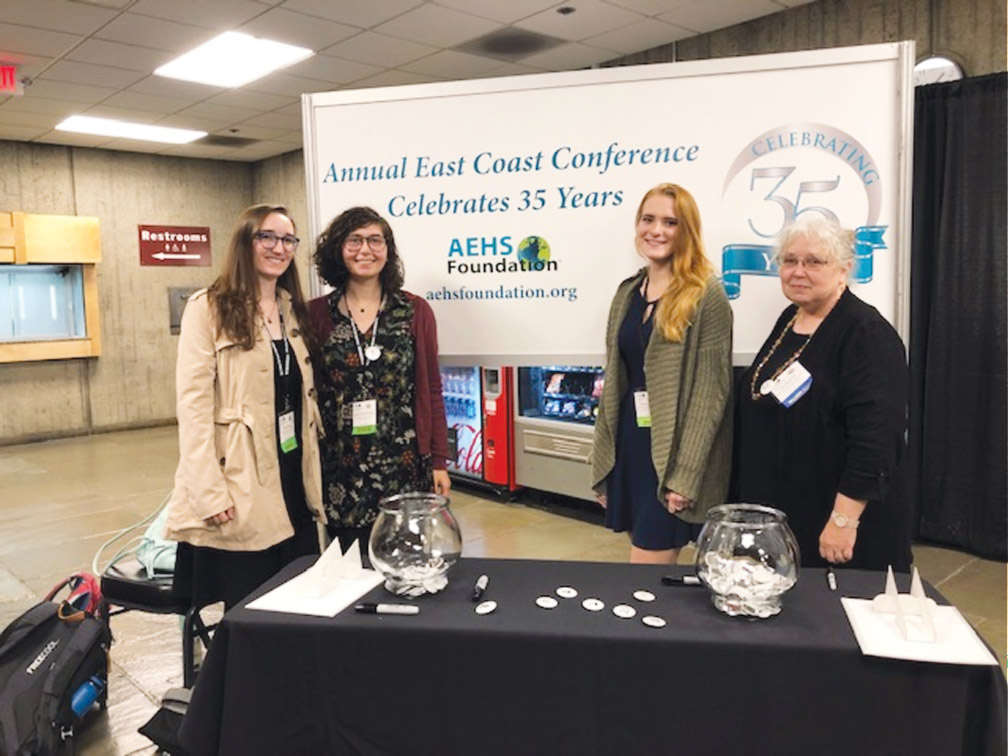Chemistry

Dr. Avik Chatterjee
Chair and Associate Professor
Department of Chemistry
apchatte@esf.edu
315-470-4747
While we have much to celebrate in the Department of Chemistry, I want to highlight a few of the more-recent accomplishments of our outstanding faculty and students.
The discovery of “living” polymers by SUNY ESF Professor Michael Szwarc revolutionized polymer and materials science. One of the most significant outcomes from this discovery was the possibility to form block copolymers with a single catalyst. Several industrially important plastics are now produced by this method. SUNY ESF chemists showed for the first time that this approach can be implemented in an environmentally-friendly fashion. Professor Ivan Gitsov and graduate student Dieter Scheibel reported the unprecedented synthesis of multi-block copolymers mediated by a single enzyme in water at ambient temperatures. These materials, constructed from renewable feedstocks, have promising biomedical potential.
Dr. Mark Teece was awarded the Public and Community Service Award for his outreach work with the local community including working with local libraries, Green Lakes State Park, and the Old Erie Canal. Dr. Teece was also awarded the SUNY ESF Foundation Teaching Award for his teaching of general chemistry and introductory chemistry courses. Jacki Torkelson, working in Dr. Teece’s research group, spent the summer in the Florida Keys completing an internship with the Mote Marine Laboratory studying ocean acidification and its effects on coral growth. Bella Luikart, an undergraduate, is working on a project in a local lake in collaboration with local residents to understand the formation of new islands in the lake. Her work has been featured in several online news articles.
In Dr. Jaime Mirowsky’s laboratory this year, with the pandemic shutting down the laboratory in the spring and early summer, as well as access to a major field site, work shifted to studying the impact of the coronavirus pandemic as it relates to changes in air quality in the New York City area. Many news reports were being published assessing how the pandemic-associated lockdown measures affected the air quality in major cities throughout the world, but little work was being done in the United States. The paper that was published, authored by Professor Mirowsky, two Ph.D. graduate students in chemistry and one Ph.D. student in environmental studies, found that when the yearly improvement of air quality and the seasonality of pollutant concentrations were documented, no major changes in air quality between the start of the pandemic going through early summer were noted.
Dr. Mark Driscoll continues his research in bio-based materials and environmental chemistry. His research group is developing nanomaterials from wood, nutshells and cellulose. The wood and nutshells are milled to nano-size particles without chemical processing. Leveraging a no-chemical processing approach results in energy savings and no or little waste. The surface of these materials can be modified to make them compatible with different resins. The research group is also studying the properties of wood-based cellulose that has never been dried or heated. This research could lead to more efficient wood-based bio-refineries. The group is investigating the use of electron beam treatment to degrade microcystin, a toxin produced by blue-green algae, in natural, drinking and wastewater. Finally, Dr. Driscoll was named the chair of an International Atomic Energy Agency (IAEA) cooperative research program on emerging contaminants of concern. This is a collaboration of 11 nations.
To keep up-to-date with the ESF Department of Chemistry, visit www.esf.edu/chemistry/ or follow us on Facebook: www.facebook.com/ESFChemistry.
Environmental and Forest Biology

Dr. Melissa Fierke
Chair and Associate Professor
Department of Environmental and Forest Biology
mkfierke@esf.edu
315-470-6809
I am excited to share just a few of the highlights from the Department of Environmental Forest and Biology over the past year. I am proud to share that Dr. Karin Limburg became the first female faculty at SUNY ESF to be named a SUNY Distinguished Professor for her sustained, excellent scholarship. This past fall, she also received a National Science Foundation grant to study hypoxia in the world’s oceans — to understand how the ocean is losing its breath
Dr. Kim Schulz received a SUNY Chancellor’s Award for Teaching in spring 2020. Though she is currently on a well-deserved sabbatical, she worked tirelessly this past summer organizing and facilitating a state-wide program in partnership with the NYDEC to combat moving aquatic invasives.
SUNY ESF and its Center for Native Peoples and the Environment, under the leadership of Dr. Robin Kimmerer ’75, was one of only a handful of institutions across the United States to participate in the Indigenous Scholars program sponsored through the Sloan Foundation. The main goal of the program is to recruit and support Indigenous (Native American, Alaskan Native, Native Hawaiian — U.S. citizenship) graduate students pursuing degrees in science, technology, engineering, or mathematics (STEM) with the intent of increasing the number of Indigenous Americans earning master’s and doctoral degrees in STEM disciplines.
Dr. Don Stewart, renowned for his research on Amazonian giant arapaima (one of the world’s largest freshwater fishes that must surface to breathe), retired in December. Dr. Danny Fernando stepped down after serving as EFB’s graduate program director for more than 12 years. Dr. Jonathan Cohen will be the new director as well as graduate associate chair. We are extremely fortunate that Dr. Greg McGee ’93 agreed to continue as EFB’s undergraduate curriculum director and coordinator for the environmental biology major.
Dr. Don Leopold was involved in three book projects this past year, including authoring “Wildflowers of the Adirondacks,” writing essays for “Wildflowers of New York City,” and a paperback release of “Trees of New York.” Dr. James Gibbs is part of a team to receive a $1.5M four-year National Science Foundation grant to explore principles that shape evolutionary processes in urban areas. He also has a new book coming out soon on Galapagos tortoises as well as another edition of his widely used and renowned “Introduction to Conservation Biology” textbook.
Dr. Jerry Belant, ESF’s first (and only) endowed professor, has projects on elk in Alaska, wolves on Isle Royale, black bears, brown bears, and lions. He also assembled the new Global Wildlife Conservation Center and led the effort for ESF to become a voting member of the International Union for the Conservation of Nature, which was recently approved.
Dr. Bill Powell’s American chestnut research program continues to be a highly successful endeavor at SUNY ESF, receiving funding from a variety of sources, publishing a multitude of papers, and drawing ever closer to re-establishing chestnut in our eastern forests.
Our newest faculty, Dr. Cynthia Downs ’04 (animal physiologist) and Dr. Josh Drew (conservation biologist), are off to excellent starts with students and multiple publications. Dr. Roxanne Razavi served as an inspiration at an international biannual mercury conference in Austria. We are incredibly fortunate to have Dr. Brian Leydet at SUNY ESF as he has worked tirelessly this past summer and fall on the College’s coronavirus efforts. Also of significant note, Dr. Hyatt Green’s lab has been leading the way in identifying COVID-19 infections in wastewater. Green also recently received National Science Foundation funding to study methylation of mercury in Green Lakes State Park. This fall, we welcomed Dr. Mike Schummer ’98 as a senior research associate. He is off to a great start with a robust lab studying waterfowl and was recently notified of a successful nearly $1 million National Science Foundation grant to study genetic diversity of mallards in North America.
Among the more than 700 undergraduates in EFB, senior Clare Foley was named the Environmental and Forest Biology Departmental Scholar for the 2019–20 academic year. Michael Whalen (Dr. Martin Dovciak, major professor) was selected by the faculty as the department’s outstanding doctoral student.
Illick has been undergoing renovations on the west end of the third and fourth floors, including an aquatics microscopy lab, a mycological intake lab, the College’s first student team room, a new departmental seminar room, a new dedicated space for Kimmerer’s Center for Native Peoples and the Environment, as well as new offices, a Terrestrial Ecology Research Lab, and extensive renovations in the sub-basement, all of which will be shared spaces with the Department of Sustainability Resources Management as Marshall Hall undergoes renovations.
Undergraduate and graduate enrollments and quality, external funding to the department, and worldwide attention in the media have never been better. Our department is doing well because of its excellent students, successful alumni, fine faculty, and dedicated staff. Please let us know how you are doing and visit us during the Homecoming Weekend/Senior Reunion in 2021. You can contact me directly at mkfierke@esf.edu or 315-470-6809.
Environmental Science

Dr. Russell Briggs
Director and Distinguished
Teaching Professor
Division of Environmental Science
rdbriggs@esf.edu
315-470-6989
“It was the best of times, it was the worst of times, it was the age of wisdom, it was the age of foolishness, it was the epoch of belief, it was the epoch of incredulity… .” Charles Dickens’ timeless opening sentence from “A Tale of Two Cities” accurately captures our experience in the Division of Environmental Science over the past year. While the challenges confronted by students navigating online learning platforms and by faculty attempting to use those platforms effectively seem daunting, we continue to work diligently to bridge the social distance void and keep our academic community engaged.
We turned the void caused by the pandemic into an opportunity by creating an interactive session between our Environmental Science B.S. program “bookend courses” (ENS132 Introduction to Environmental Science Seminar, and ENS494 Capstone Seminar). The exercise, virtually connecting seniors with first-year students, proved to be a resounding success (Figure 1). Seniors describing their successful paths through the B.S. program invigorated first-year students, providing confidence that they would successfully handle the extraordinary challenges ahead.
The environmental health program continues to grow. We hosted our largest incoming class last year; 19 students were enrolled in the Introduction to Environmental Health seminar. A notable accomplishment: under the guidance of Dr. Lee Newman, three students presented posters at the Association of Environmental Health Sciences (AEHS) annual meeting in Amherst, Massachusetts (Figure 2). Students in the environmental health program also made a positive impact on our local community as they participated in the horticulture therapy program, which serves the VA Hospital, Clear Path for Veterans, and residents of Nottingham, a senior living center.
The graduate program in environmental science (GPES) is generating renewed excitement for research and graduate education as it reorganizes into three areas of study inspired by our recent Discovery Challenge: climate and energy (C&E), ecosystems: land, water and air (ELWA), and policy, planning, communications and society (PPCS). This reorganization provides increased clarity and reduces confusion for applicants to GPES. Prior to this reorganization, applicants had to select from nine different areas of study – a formidable exercise just to apply. GPES continues to be a focal point for SUNY ESF’s interdisciplinary education and research activities.
In closing, we are making significant progress as we work to overcome the challenges of the past year. We have faced those challenges head on, working to emerge with greater strength and a renewed focus on education and research. The resilience and dedication of our learning community continue to inspire me as we contribute to molding the next generation of alumni. We continue to encourage our accomplished alumni to assist us in these endeavors by meeting with students, giving presentations in classes, and promoting SUNY ESF’s continued excellence. Here’s to a better 2021!



